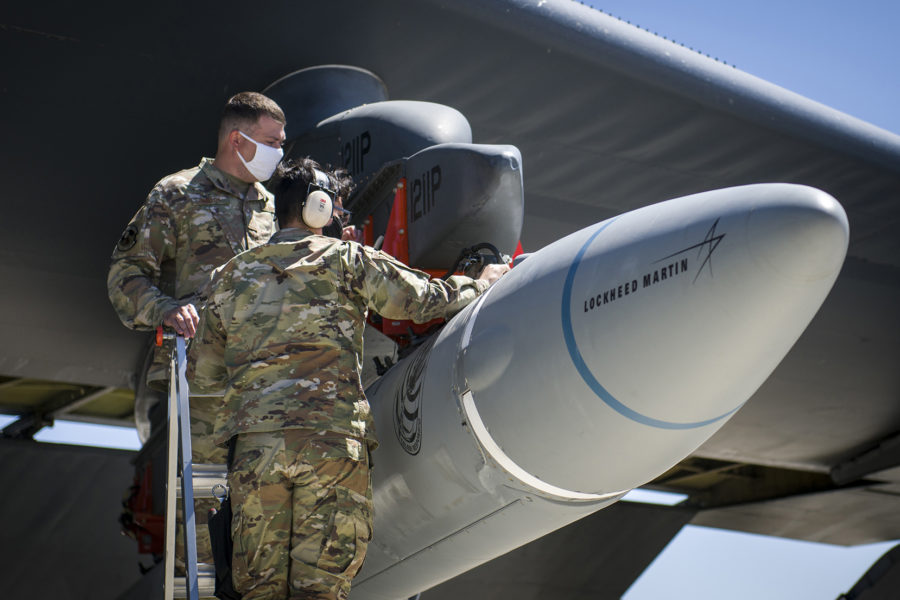The high cost of hypersonic missiles will likely drive the Air Force to build only small inventories of them, relying more heavily on other types of munitions such as lower-speed cruise missiles, Air Force Secretary Frank Kendall said Feb. 15.
“Hypersonics are not going to be cheap anytime soon,” Kendall said on a streaming broadcast with the Air Force Association’s Mitchell Institute for Aerospace Studies. “So I think we’re more likely to have relatively small inventories of [hypersonic missiles] than large ones, but that still remains to be seen, and hopefully, we can drive down the cost to where they’re more attractive.”
Kendall’s comments came the same day the Pentagon released an assessment of competition within the defense industrial base, raising an alarm that too much hypersonic expertise is being consolidated among too few companies, potentially leading to slow or little innovation and high costs.
Existing hypersonic projects such as the boost-glide AGM-183 Air-launched Rapid Response Weapon (ARRW) and the air-breathing Hypersonic Attack Cruise Missile (HACM) will “continue … in one form or another,” Kendall said, and he’s unwilling to “pre-judge” their success.
“I think there’s room for both” boost-glide and air-breathing hypersonic cruise missiles “in our inventory,” Kendall asserted. However, air-delivered hypersonic weapons are at a disadvantage, he said, because “the idea of getting there fast is sort of countered by the fact that you have to fly the airplane there before you launch the missile. So you lose some of that advantage” versus forward-based ground- or sea-launched missiles. He said he doesn’t begrudge the Army pursuing hypersonics for long-range strike because the Air Force is happy to have help in knocking out air defense systems and redundancy gives an enemy more dilemmas.
But, “the specific applications are going to have to be based on cost effectiveness and a number of other factors.”
Kendall reiterated previous comments that the U.S. and China, which is pursuing hypersonic missile technology aggressively, have different weapons needs based on their strategy. China aims to keep U.S. forces at a long distance, while the U.S. needs hypersonics mainly as a deterrent, Kendall said. The U.S. needs to be able to hit a multitude of moving targets, and “earlier versions of hypersonics tend to be [optimized more for] fixed targets.”
He said it “isn’t obvious that just because China’s doing hypersonics,” the U.S. should pursue them the same way. “And the quantities that we need might be different, certainly, than the quantities they would need.”
Kendall wonders whether “you could do the job with cruise missiles at less cost, [but] just as effectively?” Hypersonic missiles are useful “but they’re not the only way” to hit the time-sensitive targets the Air Force needs to strike.
“You could penetrate defenses with stealth and countermeasures, and so on, with a combination of tactics,” Kendall said. “So we need to look across the spectrum and make smart decisions about the munitions we buy.”
Asked if his publicly stated “disappointment” with the performance of the ARRW, which despite multiple attempts, has not yet made a complete free flight, means he might cancel it and shift resources to HACM, Kendall was noncommittal.
The ARRW “has had some test problems,” he acknowledged. “That’s not unusual in a development program.” The Air Force is still investigating the most recent test failure, and he hopes “that we’re learning from that experience.” But the service will have to “make some decisions about that weapon system, … like everything else,” depending on the results of the investigation.
Consolidation among defense suppliers is also a factor in moving the technology forward, according to the Pentagon study released Feb. 15.
On the heels of Lockheed Martin abandoning its bid to merge with Aerojet Rocketdyne after the Federal Trade Commission sued to block the deal, the Pentagon warned that “vertical integration” is harming competition in the hypersonics field.
“Many primes, first-tier subcontractors, and first-tier material suppliers are positioning themselves to acquire lower-tiered hypersonic contractors and material suppliers,” the report said, not specifically discussing the Aerojet Rocketdyne deal.
“This vertical integration will likely lead to reduced competition and may eliminate it altogether,” it said.
Further consolidation “will effectively prevent any other company from entering the market, thereby leading to reduced or limited competition, and capacity issues for the future,” the Pentagon said. That, in turn, would lead to sole-source contracting, which the Pentagon said would slow innovation and raise prices.

